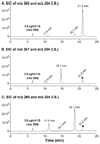LC/ESR/MS study of spin trapped carbon-centred radicals formed from in vitro lipoxygenase-catalysed peroxidation of gamma-linolenic acid
- PMID: 18484409
- PMCID: PMC2722041
- DOI: 10.1080/10715760802085344
LC/ESR/MS study of spin trapped carbon-centred radicals formed from in vitro lipoxygenase-catalysed peroxidation of gamma-linolenic acid
Abstract
Gamma-linolenic acid (GLA) has been reported as a potential anti-cancer and anti-inflammatory agent and has received substantial attention in cancer care research. One of the many proposed mechanisms for GLA biological activity is free radical-mediated lipid peroxidation. However, no direct evidence has been obtained for the formation of GLA-derived radicals. In this study, a combination of LC/ESR and LC/MS was used with alpha-[4-pyridyl-1-oxide]-N-tert-butyl nitrone (POBN) to profile the carbon-centred radicals that are generated in lipoxygenase-catalysed GLA peroxidation. A total of four classes of GLA-derived radicals were characterized including GLA-alkyl, epoxyallylic, dihydroxyallylic radicals and a variety of carbon-centred radicals stemming from the beta-scissions of GLA-alkoxyl radicals. By means of an internal standard in LC/MS, one also quantified each radical adduct in all its redox forms, including an ESR-active form and two ESR-silent forms. The results provided a good starting point for ongoing research in defining the possible biological effects of radicals generated from GLA peroxidation.
Conflict of interest statement
Figures







Similar articles
-
A combination study of spin-trapping, LC/ESR and LC/MS on carbon-centred radicals formed from lipoxygenase-catalysed peroxidation of eicosapentaenoic acid.Free Radic Res. 2009 Jan;43(1):13-27. doi: 10.1080/10715760802567606. Free Radic Res. 2009. PMID: 19085251 Free PMC article.
-
An advanced Electron Spin Resonance (ESR) spin-trapping and LC/(ESR)/MS technique for the study of lipid peroxidation.Int J Mol Sci. 2012 Nov 12;13(11):14648-66. doi: 10.3390/ijms131114648. Int J Mol Sci. 2012. PMID: 23203086 Free PMC article. Review.
-
Identification of spin trapped carbon-centered radicals in soybean lipoxygenase-dependent peroxidations of omega-3 polyunsaturated fatty acids by LC/ESR, LC/MS, and tandem MS.Free Radic Biol Med. 2003 Jul 1;35(1):33-44. doi: 10.1016/s0891-5849(03)00217-x. Free Radic Biol Med. 2003. PMID: 12826254
-
Identification of all classes of spin-trapped carbon-centered radicals in soybean lipoxygenase-dependent lipid peroxidations of omega-6 polyunsaturated fatty acids via LC/ESR, LC/MS, and tandem MS.Free Radic Biol Med. 2003 Apr 15;34(8):1017-28. doi: 10.1016/s0891-5849(03)00031-5. Free Radic Biol Med. 2003. PMID: 12684086
-
In Vivo and In Situ Detection of Macromolecular Free Radicals Using Immuno-Spin Trapping and Molecular Magnetic Resonance Imaging.Antioxid Redox Signal. 2018 May 20;28(15):1404-1415. doi: 10.1089/ars.2017.7390. Epub 2017 Dec 11. Antioxid Redox Signal. 2018. PMID: 29084431 Review.
Cited by
-
Characterization of novel radicals from COX-catalyzed arachidonic acid peroxidation.Free Radic Biol Med. 2009 Sep 1;47(5):568-76. doi: 10.1016/j.freeradbiomed.2009.05.023. Epub 2009 May 28. Free Radic Biol Med. 2009. PMID: 19482075 Free PMC article.
-
The first characterization of free radicals formed from cellular COX-catalyzed peroxidation.Free Radic Biol Med. 2013 Apr;57:49-60. doi: 10.1016/j.freeradbiomed.2012.12.004. Epub 2012 Dec 20. Free Radic Biol Med. 2013. PMID: 23261941 Free PMC article.
-
A combination study of spin-trapping, LC/ESR and LC/MS on carbon-centred radicals formed from lipoxygenase-catalysed peroxidation of eicosapentaenoic acid.Free Radic Res. 2009 Jan;43(1):13-27. doi: 10.1080/10715760802567606. Free Radic Res. 2009. PMID: 19085251 Free PMC article.
-
LC/ESR/MS study of pH-dependent radical generation from 15-LOX-catalyzed DPA peroxidation.Free Radic Biol Med. 2011 Oct 1;51(7):1461-70. doi: 10.1016/j.freeradbiomed.2011.07.001. Epub 2011 Jul 19. Free Radic Biol Med. 2011. PMID: 21807091 Free PMC article.
-
An advanced Electron Spin Resonance (ESR) spin-trapping and LC/(ESR)/MS technique for the study of lipid peroxidation.Int J Mol Sci. 2012 Nov 12;13(11):14648-66. doi: 10.3390/ijms131114648. Int J Mol Sci. 2012. PMID: 23203086 Free PMC article. Review.
References
-
- Fan YY, Chapkin RS. Importance of dietary g-linolenic acid in human health and nutrition. J Nutr. 1998;128:1411–1414. - PubMed
-
- Harbige LS. Fatty acids, the immune response, and autoimmunity: a question of n-6 essentiality and the balance between n-6 and n-3. Lipids. 2003;38:323–341. - PubMed
-
- Calder PC, Zurier RB. Polyunsaturated fatty acids and rheumatoid arthritis. Curr Opin Clin Nutr Metab Care. 2001;4:115–121. - PubMed
-
- Darlington LG, Ramsey NW. Review of dietary therapy for rheumatoid arthritis. Compr Ther. 1994;20:490–494. - PubMed
-
- Horrobin DF. Essential fatty acid metabolism and its modification in atopic eczema. Am J Clin Nutr. 2000;71:367S–372S. - PubMed
Publication types
MeSH terms
Substances
Grants and funding
LinkOut - more resources
Full Text Sources
Miscellaneous
